Taking Indian wildlife right into classrooms
Posted by Remya Padmadas on January 11, 2018Last year in November, Pratham Books launched a brand-new set of four PhoneStories that invited readers to take a walk in the wild. The books were written by Sejal Mehta, travel writer, wildlife enthusiast, and Editor-in-Chief, Nature inFocus and illustrated by the award-winning cartoonist Rohan Chakravarty of Green Humour fame. Captivating visuals and simple story lines lent themselves to audio-visual adaptation that could be enjoyed on a variety of handheld devices and that were sure to engage young readers.
Payoshni Saraf and Khyati Datt write about how they ensured the stories reached teachers, classrooms and most importantly, children, through their outreach efforts.
The wildlife set of #Phonestories was an exciting set of books. The books were short and simple, visually arresting and aurally engaging- guaranteed to capture the attention of the tiny tots!
We chose a set of partners for the exclusive on-ground launch keeping in mind the age group the books were meant for, which was under Grade 4. Our chosen partners, including Pratham Delhi, Pratham ECE, Pratham's Learning with Vodafone project, Agastya Foundation and Pratham's Smart Step Preschools worked in the space of early literacy with a focus on Science and Environment.
Direct to teachers’ phones
More and more organisations are using WhatsApp these days to connect their on-field employees for swifter communication and sharing of information. For education organisations specifically, WhatsApp groups connect educators to draw from each other’s experiences and learn collectively. This was why we chose WhatsApp as our primary vehicle for campaign communication with teachers for #PhoneStories. Also, since the stories were available in video format, we believed that sending them directly to educator’s phones would make it easier for them to access.
Thanks to the collaboration with our partner organisations, #Phonestories reached 2,800 Schools/ Centres and teachers impacting over 56,000 children. We engaged with participating educators twice a week via the WhatsApp groups.
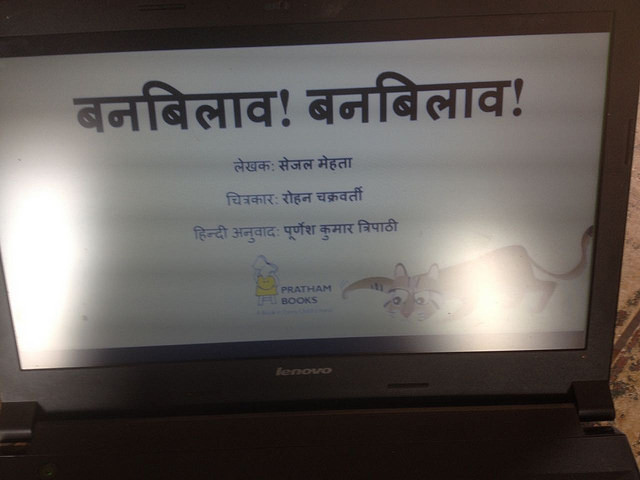
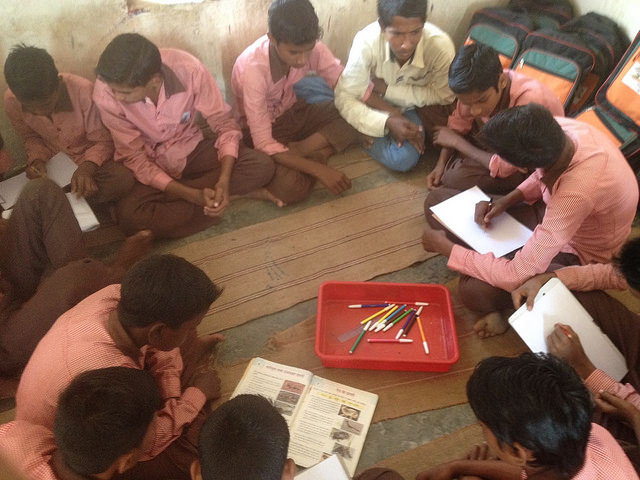
A session in progress for बनबबलाव! बनबबलाव! in an Agastya Foundation centre in Chandauli, U.P.
We first shared a 4-week reading plan with the teachers of participating organisations, post which, every Thursday, one book and 2 related activities were shared. Teachers were appreciative of the detailed activities related to the books as it helped engage children further with the story and its concept. We also conducted fun contests for the teachers on the WhatsApp groups, where they sent their entries via WhatsApp too. We found WhatsApp to be a quick, direct and effective way of communicating with teachers.
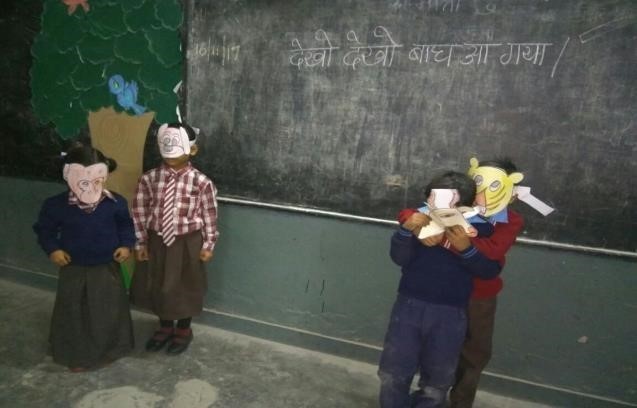
An activity being done for Watch Out! The Tiger Is Here at a Pratham Delhi centre
Going Forward
We hope to continue exploring WhatsApp as a channel of communication with our outreach partners in the future to share great content and new updates from us!
You can read, watch and listen to all four PhoneStories here.
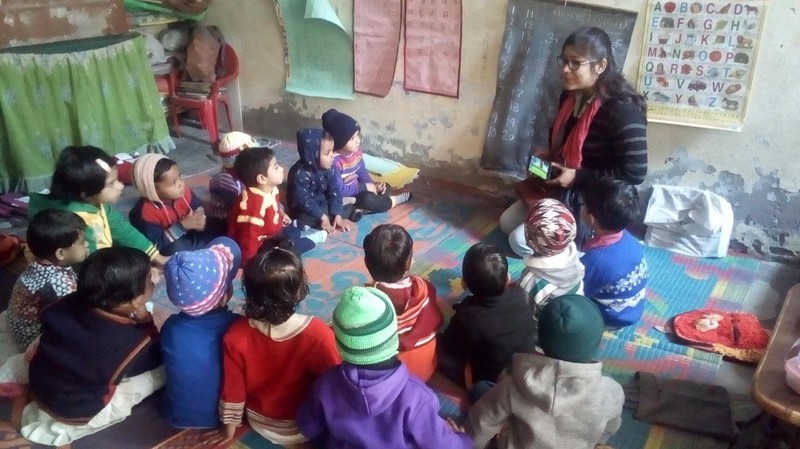
Did You Hear? being read in a Pratham ECE Centre.
Be the first to comment.
Taking Friendship and Curiosity to Classrooms
Posted by Remya Padmadas on September 07, 2017Zeba Imtiaz, Assistant Editor, Pratham Books writes about her experience at a recent storytelling session at Citizens High School, Bangalore.
We recently accompanied Roopa Pai, author and editor of a formidable number of STEM books, on a story telling session at Citizens High School in Bangalore. The STEM books have been written and created with support from Oracle, and the event was organised with the help of our partner organisation - Mantra4Change. The intent of these sessions is to bring creators and readers together to read stories, play games, and most importantly, learn more from each other.
Last weekend found us at the gates of the school, listening to the chirpy voices of the only other bunch of humans who can be as excited as us about a working Saturday morning – school going children. Citizens School, located on Davis Road, Bangalore, is an English medium school for children from low income families, and has a building for the primary section, and another building down the road for the senior kids.
Roopa had chosen to read ‘How Old is Muttajji?’ to a class of 6th graders in the senior school building. This is a story about two enthusiastic twin detectives trying to deduce the age of their great grandmother from various events in her life. And we decided to go along with ‘Same Same or Different’, a story of a sparrow and a snake who try to show their parents they can be friends despite their obvious differences, for a class of 4th graders.
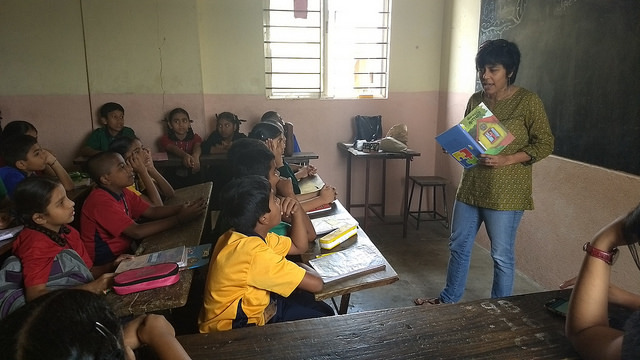
In Grade 6th, Roopa had 35 kids on the edge of their benches wondering along with Putta and Putti what is their Muttaji’s real age. Gathered in their ancestral home in Mysore, the twins used History, Mathematics and General Knowledge to come to the exact birthday their great grandmother was celebrating! The kids were amused, intrigued and fascinated by the interesting bits of history spread through the book and the twins’ investment in cracking the clues. After the story, Roopa quizzed the children on Indian history. The class was divided into groups and their knowledge on India’s history and culture was tested. There was a lot of competition and guess work in the air (not to say noise!) and the session ended on a high with all the energy from the children!
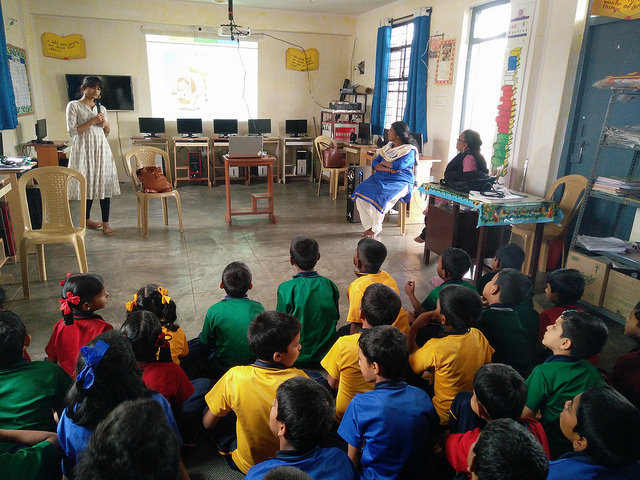
We projected and read out the story ‘Same Same or Different’ to the very excited class of 4C in a charming library on the sunshine-filled terrace of the school. The colourful characters, the emotions, and the very real problem of your friend not being approved of by your parents, made the story come alive for the kids and us. After some impassioned reactions to the parenting skills of Mama Sparrow and Papa Snake, we moved onto our activity for the day. The kids partnered up with whoever was seated next to them, and were given coloured pens and activity sheets. The activity sheet had a venn diagram, exactly like the one Sparrow and Snake use in the story. The kids talked to their partners about their hobbies, favourite foods and games and colours, and birthdays, and filled in what was common to both of them, and what was different. We then counted our ‘same-sames’ and ‘differents’ and talked about whether that affected our relationships, and whether that was even an important thing to consider.
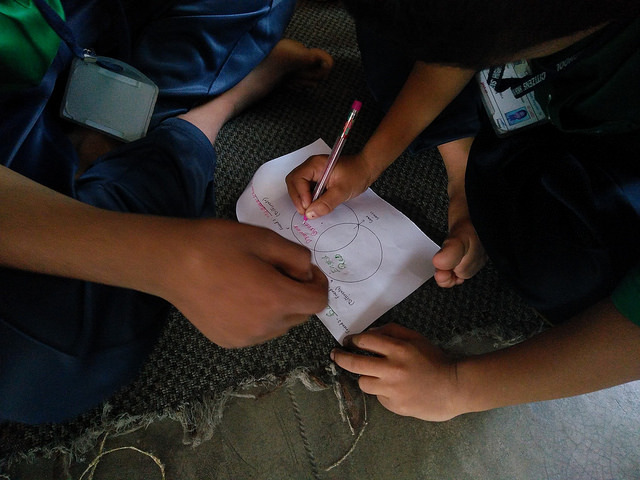
After multiple photographs, viewings of activity sheets, and thank yous, we ended our session with many learnings on how kids view their friendships and parental relationships.
You can see more pictures from the sessions on the StoryWeaver Flickr Account.
Be the first to comment.Welcome to Kishanganj
Posted by Remya Padmadas on August 01, 2017For the last 13 years, Pratham Books has published 300 titles in 18 languages and helped put them in the hands of 3 million children. But in a linguistically diverse country like India with 122 major languages and 1599 ‘other’ languages, achieving the mission of ‘a book in every child’s hand’ becomes a challenge.
StoryWeaver was envisioned as a means through which we could significantly scale the creation of joyful reading material for children in a language they’re fluent in, whether it’s a mainstream, minority, tribal or endangered language. These are languages that are traditionally overlooked by mainstream publishing. Since its launch, StoryWeaver has played a small but key role in the preservation of these languages, by providing language champions, teachers and authors a platform on which they can translate, create, download, print and share stories with ease and for free.
Surjapuri is a lesser known Bengali dialect is spoken in pockets of Bihar, West Bengal, Assam and Bangladesh by 1.2 million people. In Bihar, the language is spoken in Kishanganj, Katihar, Purnia and Araria districts.
As many of the villages in the Kishanganj district are located in the interior realms of the district, they have little by way of basic infrastructure and primary health care. The literacy rate is low and primary schools often lack even the most basic facilities. As most of the high schools are located in Kishanganj and Thakurganj towns which are far from the villages, girls tend to discontinue their education leading to a high drop-out rate.
The Azad India Foundation
The Azad India Foundation (AIF) was founded by Yuman Hussain in 1998 to seed initiatives in education and primary health care. The activities reach out to marginalized women, adolescents and underserved children from rural and urban areas of Kishanganj district. AIF has 73 learning centres impacting 3500 children directly in the area. StoryWeaver is periodically used in these centres.The children in AIF’s centres are aged between 6 - 9 years and are either school dropouts or children attending Madrassas. The centre’s syllabus includes Hindi, English, Science and Maths.
Yuman Hussain shared “The main aim of the initiative is to ensure that children are ready to merge with mainstream education in state-run schools by grade 4. Literacy initiatives play a big role in ensuring this. The children that I engage with at the learning centres have never seen a story book in their mother tongue. Even my teachers haven’t read books in Surjapuri.”
Previously, AIF used printed storybooks in the centres and were limited by the number of books they could source. Plus, these books were not in Surjapuri.Through StoryWeaver AIF has access to thousands of stories free of cost.
“The reading culture among children is diminishing.” says Yuman. “I can put together a sizeable bank of stories from StoryWeaver as they are freely available and nudge the children towards reading. Before I came across StoryWeaver, I hadn’t thought of translating stories for the children. When I realised that it was so easy on the platform, I decided to give it a shot. The level 1 and 2 books were really fun and straightforward and I felt perfect for the children we worked with. Translating on StoryWeaver for children has made me realise the importance of picking the ‘right’ words in line with the reading level and the essence of the story. Also, Surjapuri has minor variations across villages, so choosing a word that would be understood across speakers was also an enjoyable challenge for me.”
The AIF Centres are not tech equipped as there are electricity issues in the villages. So Yuman picks stories to read to children or for translation at the AIF office in Kishanganj where there is better connectivity. She uses Google Input Tools for translations and then, pastes the text in the StoryWeaver editor. After translating the stories, they are downloaded, printed and distributed to teachers who then carry the stories to the learning centres to read to children.
Yuman strongly believes that reading books in Hindi and English will improve the children’s language skills. “Plus, if educational concepts are taught through stories in their mother tongue and if we engage children in activity based learning, they are more eager to learn and will grasp the concepts better.”
Yuman was motivated by reading how other educators were using StoryWeaver in their classrooms.
“The stories were received very positively by the children. The stories in Surjapuri, the mother tongue of the children, left them amazed. I plan to keep exposing the children to more and more stories with the hope that they will then start to read voluntarily over the course of time.”
Watch this short video about AIF.
Be the first to comment.